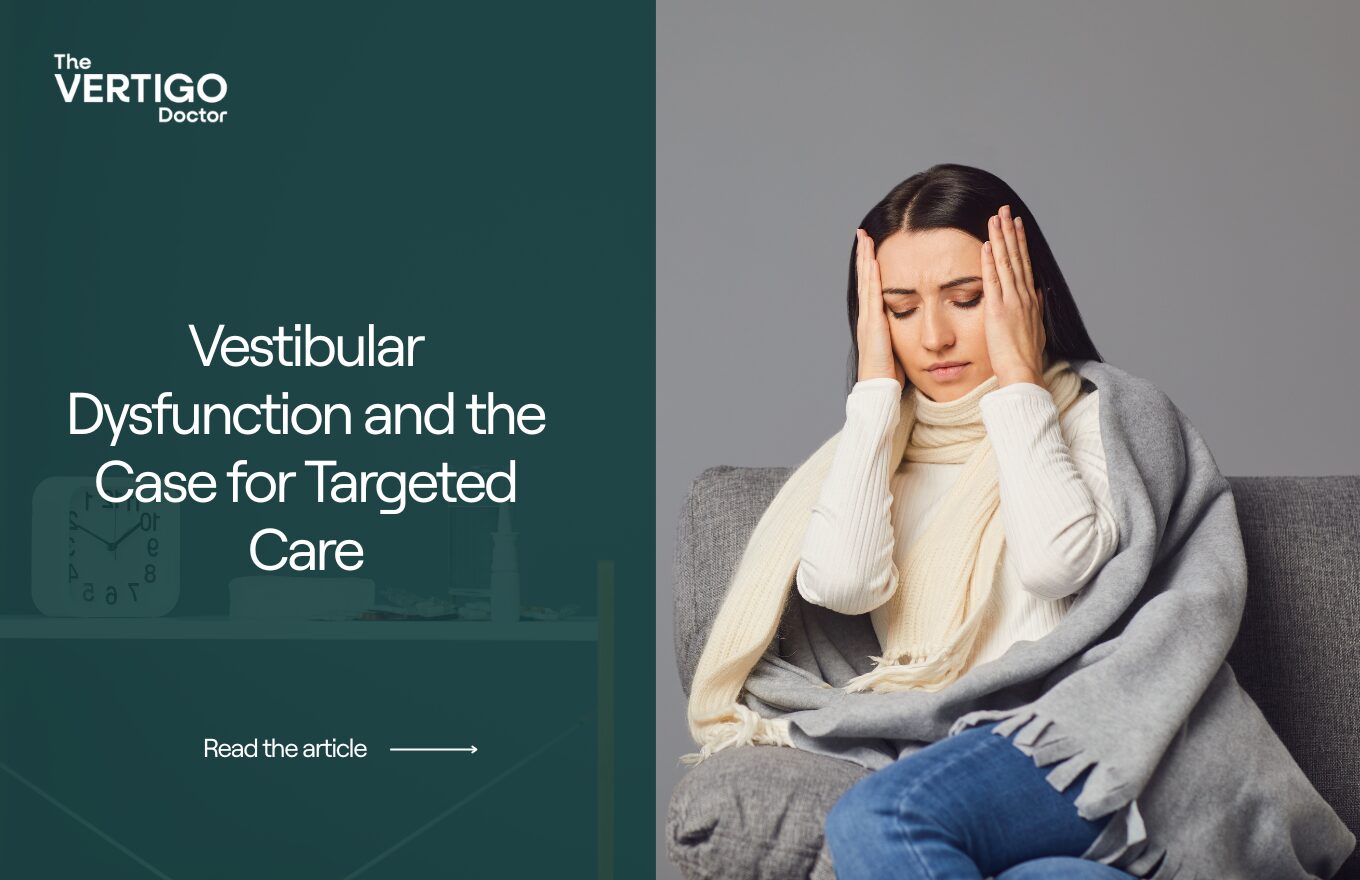What is Vertigo?
Vertigo is the incorrect perception that you, or the room around you, is moving, sliding, or spinning. It is not a diagnosis, rather it is a symptom of many different diagnoses that can occur in your inner ear or in your brain.
Common Causes of Dizziness & Vertigo
Vertigo can result from various inner ear, brain, or nervous system conditions—some temporary and treatable, others chronic and requiring ongoing care. Here are common causes.
BPPV (Benign Paroxysmal Positional Vertigo)
Vestibular Migraine
Vestibular Neuritis or Labyrinthitis
Meniere's Disease
PPPD (Persistent Postural-Perceptual Dizziness)
Anxiety-related dizziness
Common Symptoms
Vertigo isn't just distracting, it can feel like it's hijacking your body. Spinning, imbalance, tilting, dropping, and more can make every day tasks feel risky or scary.
You may feel like everything makes your symptoms flare, and not even know why. Though episodes may pass at first, the symptoms may become more chronic or change with time.

-
Spinning sensation
The feeling that you or your surroundings are moving or rotating, often associated with dizziness or imbalance. It can be caused by inner ear issues, motion sickness, or other medical conditions.
-
Loss of balance
A feeling of unsteadiness or wobbling that makes it difficult to stand, walk, or move safely. It can be caused by inner ear issues, medication, or other health conditions.
-
Nausea or vomiting
The sensation of feeling sick in the stomach, sometimes leading to the urge to vomit, often caused by illness, motion, or vertigo.
-
Feeling pulled to one side
A sensation of being feeling pulled to one side is a sensation of being unsteady or tilted, as if gravity is pulling you sideways, often linked to inner ear issues or balance disorders.
-
Trouble focusing
A sensation of being feeling pulled to one side is a sensation of being unsteady or tilted, as if gravity is pulling you sideways, often linked to inner ear issues or balance disorders.
-
Room “tilting” or swaying
The sensation that room “tilting” or swaying is the sensation that your surroundings are moving or shifting, even when you are still, commonly associated with vertigo or balance problems.
Is it really Vertigo?
Dizziness or a spinning sensation can feel like vertigo, but other factors like low blood pressure, dehydration, or inner ear issues may be the cause.
When should you get help?
If your vertigo comes on suddenly, lasts longer than a few days, or keeps coming back — it’s time to speak with a healthcare provider. If you’re struggling with daily activities, treatment can help.
Start with your primary care provider. They may refer you to:
- An ENT
- A neurologist and/or headache specialist
- Vestibular physical therapist neurootologist (neuroENT)

Hi! I’m Dr. Madison Oak
I truly believe that everyone with vertigo, vestibular disorders, and/or dizziness deserves answers. And I believe those answers should be accessible and cost-effective. That’s exactly why I created Vestibular Group Fit.
Our team

Dr. Jenna Green
PT, DPT, CCVR

Bridgette Jensen
BFA Dance

Candy Price
YT 200, NASM, Ayurveda Certification

Kelsey Voskamp
Taekwondo Blackbelt, Fitness trainer, Reiki Healer

Trineta Bhojwani
Physical Therapist, neurological specialist
Vestibular Group Fit membership
So you can feel like you again
- 8-9 new workouts, safe for dizziness, weekly
- Access to Vestibular Experts at your fingertips
- Educational content
- 6 week neck protocol for neck pain & dizziness
- 30% Off supplements with fullscript (US only, 10% in CAN)
- 24/7 support group access
- 6 Week Neck Strength Course
- Mindset work to break the dizzy-anxious-dizzy cycle
- 2 live group coaching calls
- Access to 1:1 calls for an additional charge
Start your VGfit journey with an onboarding quiz to tailor the content to your specific needs and diagnosis. You will always have all the tools you need to thrive, right at your fingertips
In VGFit, youl always have access to expert guidance. The ability to ask any question 24/7, get answers quickly, and find others who are similar to you. That way, youll never be alone in managing your dizziness
We’re here to help you
Frequently asked questions
View all FAQVestibular Group Fit is a comprehensive program designed to take a holistic approach to managing your vestibular disorder. Chronic vestibular symptoms do get better, and can be treated, always. That being said, there are many things that you may need to do or change in order to get there. Vestibular Group Fit (VGF) takes all of these facts into consideration and creates you custom programming based on your needs, diagnoses, and symptoms. Then, we start with The Basics. The Basics are the main focuses of VGF to really get down before moving forward with treatment. You will learn how to eat and hydrate, sleep better, change your mindset to break the dizzy-anxious-dizzy cycle, and more. All of this from the comfort of your own home, without any of the triggering head movements. Returning to function and getting your life back doesn’t have to be triggering, it can be gentle and consistent in order to be most effective.
A Vestibular disorder is a dysfunction of your vestibular system. First we need to back up, though. The vestibular system is your inner ear’s system of balance. You have 3 systems of balance, your vestibular system, the visual system, and proprioception. These 3 systems work together to provide optimal balance and equilibrium. Your vestibular system is deep within your inner ear and attached to the cochlea, which is your hearing organ. Just like with any other organ or bodily system, things can go wrong in the vestibular system. about how the system functions generally here.
There are 2 main factors that define vestibular disorders. The first is a peripheral vestibular disorder, which you can learn more about , and is a disorder that occurs in the actual vestibular system itself. Then there are central vestibular disorders, to learn more, which occur in the brain but cause vestibular symptoms.
All you need to do is bring yourself! As you start with the strength training, you may need weights, but you may always use household items such as cans, bags loaded with subjectively heavy objects, or anything else you can find around the house.
No, you do not need Facebook to participate in VGFit. All exercises, information and resources included in VGFit are available on both The Vertigo Doctor website and on Facebook, within the VGFit group.
The only difference between the platforms is access to VGFit Community Discussion Group, which is only available on Facebook. While we encourage joining the FB community group to connect and share with other VGFit members, participation is completely optional.
No, Vestibular Group Fit (VGFit) is not the same as Vestibular Rehabilitation Therapy (VRT). They are different approaches but can complement each other in managing dizziness.
VGFit focuses on foundational exercises to help you feel better quickly, enabling you to participate in a VRT clinic and perform specific exercises without worsening your condition. VRT is a medical physical therapy practice involving exercises such as VORx1 or VORcX, which involve shaking or spinning your head or body.
As a vestibular therapist, Dr. Madison prescribes these VRT exercises, but they are not her first line of treatment for vestibular migraine. It is important to build a foundation by regulating your nervous system, balancing your blood sugar, and work on your mindset and more. By taking these steps first, you create a foundation that allows VRT to be more effective. Without this initial preparation, VRT might not be as successful or might not work at all.
This is completely up to you!
While you do not need a formal diagnosis to join VGFit, you should get clearance from your doctor before starting any new activity or exercise program. Before joining, we recommend being cleared for exercise, meditation, breathing exercises, and participating in a new program for your dizziness.
Dizziness comes from many different places and sources, the most common being a vestibular disorder. There are two groups that we can generally put dizziness and vertigo diagnosis into. The first are central disorders (brain and spinal cord) and the second are peripheral disorders (in the actual vestibular system). The most common central vestibular disorder is vestibular migraine, and the most common peripheral vestibular disorder is BPPV.
The best treatment for BPPV is a canalith repositioning maneuver, such as the Epley or BBQ Roll. The best treatment for Vestibular Migraine is a larger treatment plan that focused on lifestyle, mindset, movement, and more. That is precisely what we do in Vestibular Group Fit, provide you with everything you need to know about living with dizziness, from which doctors to see to how to move your body safely again.
Still not sure vestibular group fit is right for you?
I’d love to chat with you about any questions, comments, or concerns you may have about Vestibular Group Fit!
Send email to Dr.Madison


